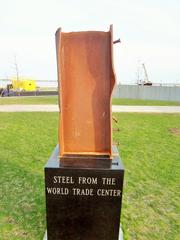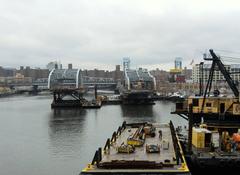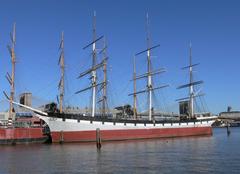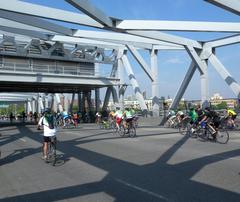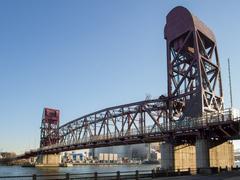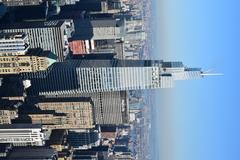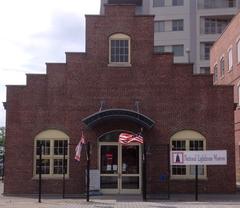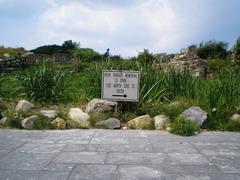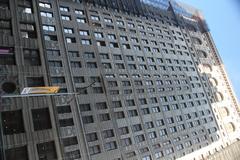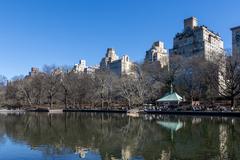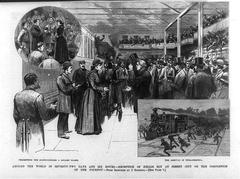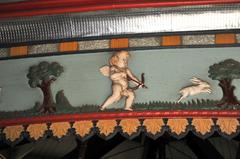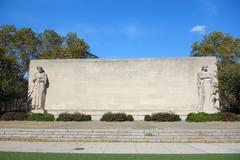
Comprehensive Guide to Visiting ‘To the Struggle Against World Terrorism’ in New York City
Date: 24/07/2024
Introduction
The ‘To the Struggle Against World Terrorism’ monument, also known as the ‘Tear Drop Memorial,’ stands as a poignant symbol of international solidarity and grief. Conceived as a gift from the Russian government to the United States, this monumental structure was proposed by Russian President Vladimir Putin in the aftermath of the September 11, 2001, terrorist attacks. Designed by renowned Russian sculptor Zurab Tsereteli, the monument encapsulates the shared sorrow and resilience in the face of global terrorism. The 100-foot-tall tower, split to reveal a 40-foot stainless steel teardrop, is a powerful representation of the wounds inflicted by terrorism and the collective tears shed for the victims (Amusing Planet) (Wikipedia).
Despite its noble intentions, the monument has faced various controversies and criticisms, ranging from its aesthetic value to political implications. Nevertheless, it remains a significant cultural and historical landmark, attracting visitors who seek to honor the victims of terrorism and reflect on the ongoing struggle against such threats. This comprehensive guide will delve into the history, design, and visitor information of the ‘Tear Drop Memorial,’ providing valuable insights for those planning a visit to this poignant site.
Table of Contents
- Origins and Conception
- Design and Construction
- Dedication Ceremony
- Controversies and Criticisms
- Significance and Impact
- Visitor Experience
- Ticket Prices and Visiting Hours
- Nearby Attractions and Travel Tips
- Accessibility
- Special Events and Guided Tours
- FAQ Section
Visiting the ‘Tear Drop Memorial’ - History, Significance, and Visitor Information
Origins and Conception
The monument known as ‘To the Struggle Against World Terrorism,’ also referred to as the ‘Tear of Grief’ or ‘Tear Drop Memorial,’ was conceived as a gift from the Russian government to the United States. The idea was proposed by Russian President Vladimir Putin in the aftermath of the September 11, 2001, terrorist attacks. The monument was intended to symbolize solidarity and the shared grief between the two nations in the face of global terrorism.
Design and Construction
The monument was designed by the renowned Russian sculptor Zurab Tsereteli. The design features a 100-foot-tall tower made of bronze and steel, split down the middle to reveal a large, stainless steel teardrop. The teardrop itself is 40 feet high and weighs approximately 4 tons. The split in the tower symbolizes the wound inflicted on the world by terrorism, while the teardrop represents the tears shed for the victims of such attacks.
Construction of the monument began in 2004 and was completed in 2006. The project faced several logistical challenges, including the transportation of the massive structure from Russia to the United States. The monument was shipped in pieces and assembled on-site in Bayonne, New Jersey, just across the Hudson River from New York City.
Dedication Ceremony
The dedication ceremony for the ‘Tear Drop Memorial’ took place on September 11, 2006, marking the fifth anniversary of the 9/11 attacks. The event was attended by various dignitaries, including former U.S. President Bill Clinton and Russian officials. During the ceremony, speeches emphasized the importance of international unity in the fight against terrorism. The monument was officially unveiled to the public, and it has since become a site of reflection and remembrance.
Controversies and Criticisms
Despite its noble intentions, the ‘Tear Drop Memorial’ has not been without controversy. Some critics have questioned the aesthetic value of the monument, describing it as overly dramatic or even kitschy. Others have raised concerns about the political implications of accepting a gift from Russia, especially given the complex and often strained relations between the two countries.
Additionally, there have been logistical criticisms regarding the monument’s location. Situated in a relatively obscure part of Bayonne, the memorial is not as easily accessible to the general public as other 9/11 memorials in New York City. This has led to debates about whether the monument receives the attention and recognition it deserves.
Significance and Impact
Despite the controversies, the ‘Tear Drop Memorial’ holds significant symbolic value. It serves as a poignant reminder of the global impact of terrorism and the importance of international solidarity in combating such threats. The monument has also become a place of pilgrimage for those wishing to pay their respects to the victims of 9/11 and other acts of terrorism.
The ‘Tear Drop Memorial’ is inscribed with the names of the victims of the September 11 attacks, as well as those who perished in the 1993 World Trade Center bombing. This inclusion underscores the ongoing struggle against terrorism and the enduring need to remember and honor those who have lost their lives.
Visitor Experience
For those planning to visit the ‘Tear Drop Memorial,’ there are several practical considerations to keep in mind. The monument is located at the end of the former Military Ocean Terminal in Bayonne, New Jersey. Visitors can access the site by car, with ample parking available nearby. Public transportation options are more limited, but the site can be reached via a combination of train and bus services from New York City.
Ticket Prices and Visiting Hours
There is no admission fee for the ‘Tear Drop Memorial,’ making it accessible to all visitors. The memorial is open to the public year-round, but it is advisable to check the local Bayonne city website for any updates on visiting hours or special events.
Nearby Attractions and Travel Tips
While visiting the ‘Tear Drop Memorial,’ consider exploring other historical sites in Bayonne. The city offers a variety of parks, museums, and waterfront areas. Additionally, the location provides stunning views of the New York City skyline, making it an ideal spot for photography.
Accessibility
The ‘Tear Drop Memorial’ is designed to be accessible to all visitors, including those with disabilities. The site offers pathways and areas that accommodate wheelchairs and strollers. For more detailed information, visitors can refer to the Bayonne city website.
Special Events and Guided Tours
Occasionally, special events and guided tours are organized at the ‘Tear Drop Memorial.’ These events often focus on remembrance and education about terrorism and its impacts. Check the Bayonne city website for upcoming events and tour schedules.
FAQ Section
What are the visiting hours of the Tear Drop Memorial?
The memorial is open to the public year-round. For specific visiting hours, it is best to check the Bayonne city website.
Is there an admission fee for the Tear Drop Memorial?
No, there is no admission fee for visiting the ‘Tear Drop Memorial.’
How can I get to the Tear Drop Memorial?
The memorial is located at the end of the former Military Ocean Terminal in Bayonne, New Jersey. It is accessible by car with ample parking available. Public transportation options are limited but can be utilized via a combination of train and bus services from New York City.
Conclusion
The ‘To the Struggle Against World Terrorism’ monument, or ‘Tear Drop Memorial,’ stands as a powerful symbol of international unity and remembrance. Despite its controversial design and mixed reception, it remains a significant cultural and historical landmark. Visitors to the site can reflect on the shared grief and resilience that unite nations in the face of terrorism, making it a poignant and memorable experience (New Yorker) (Snopes).
References
- ‘The Tear Drop Memorial: A Forgotten Monument,’ Amusing Planet, 2015 amusingplanet.com
- ‘To the Struggle Against World Terrorism,’ Wikipedia wikipedia.org
- ‘Monument,’ New Yorker, 2007 newyorker.com
- ‘Tear Drop Monument,’ Snopes snopes.com
